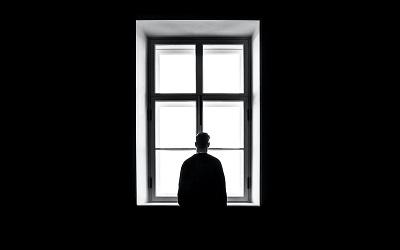Working on a Creative Writing PhD during a pandemic lockdown: Cold Dark Matter

Patrick Wright teaches Literature and Creative Writing at The Open University and is currently studying for a PhD in Creative Writing. In this piece, Patrick shares his experience of studying for a PhD during lockdown while also mourning the loss of his partner.
1. My PhD in Creative Writing, supervised by Siobhan Campbell and Jane Yeh, is a poetry collection with the working title Cold Dark Matter.
It also has a critical component on the ekphrasis [a literary and rhetorical trope of summoning up—through words—an impression of a visual stimulus, object, or scene] of modern and contemporary art. I’m particularly interested in the strategies and techniques that an ekphrasis practitioner may employ when writing poems in response to highly abstract or monochromatic paintings, such as those by Mark Rothko.
More recently, (and in part due to the restrictions imposed due to the pandemic), I’ve been looking specifically at ekphrasis in the digital age: writing about artworks re-mediated by a computer screen or iPhone.
I’m on course for my submission deadline (October 2022), and making good progress.
2. Days of having any semblance of a community are now a distant memory. The introversion that, by now, is an accepted part of my life as a poet has intensified to the point of solipsism. Time has ceased to exist in the way it was, and now torpor and lassitude are the order of the day. Structure and routine are key, along with regular expressions of gratitude.
3. After having completed my first PhD (in 2007), I am familiar with the isolation and loneliness that research can bring; the ideas just too rarefied for most people. However, this time, I’ve found I’ve had to develop a survival mode that contends not only with working on a doctoral thesis, but also with living alone and working from home (as an Associate Lecturer), while grieving the loss of my partner.
Understandably, personal themes of loss and bereavement find their way into my ekphrases, as I seek to mediate the metaphysical questions that arise, and find, in the world of art, metaphors for trauma and devastation.
4. Cafés as a working environment have now, I realise, become incredibly important to me as a poet. I miss finding that optimum decibel level (just the right amount of background hubbub and human presence), and the necessary creative flow state. With my present circumstances as they are, to take myself to such places offers me a vague sense of connection – even if I’m just observing or half-overhearing conversations.
5. On my new picnic table in my back yard is a book on de Chirico: the glossy plates of deserted city squares just like Twitter photographs of my own city during lockdown. In these images and news reports, people are conspicuously absent; and in place of the human zoo – once a feature of many urban centres – there’s now the invasion of goats, having wandered down from the hillside.
6. My writing practice, outside, is now accompanied by birdsong, a too-bright sun making the paper painful to look at, and the faint whiff of marijuana from the suburban street.
7. Ordinarily, I’d be touring the U.K., drawn to exhibitions as part of my practice research. This has included arranging private viewings with curators – where I’m often led to the holdings, supervised by gallery staff. Or I’ll spend time in the designated public areas, absorbing the wider milieu and paratext around the image: the frame, the blurb, the comments of tourists, or my reflection in the glass.
8. Instead, I’ve had to embrace the virtual galleries on offer, (such as an online tour of Kettle’s Yard), and Andre Malraux’s concept of ‘the imaginary museum’. Though it’s fair to say that my ekphrasis is not significantly affected by looking at a reproduction rather than the original, there are missing dimensions in my act of observation. These include the texture of the paint, the smell of the room, possible tactile experiences, and so on.
9. I’ve made more use of Google Images in recent weeks, which I’ve found to be just as enabling as any perceived barrier to the materiality of the artwork.
Moreover, my own library has become endlessly fascinating, as I live out a similar narrative to the one in Xavier de Maistre’s A Journey Around My Room.
Regardless of scholarly merit, I love older books on art history, especially those with foxing on the pages or tissue paper over the plates. I write in response to these, and my collection of exhibition catalogues. Such sources, as I see them, are legitimate artworks in their own right.
10. Perhaps inevitably, a new set of poems have been written using the diction of the day – ‘furlough’, ‘key workers’, ‘lockdown’ – which will (if ever they’re published) immediately date my practice for any attentive reader.
11. My Netflix habits now centre on post-apocalyptic zombie shows – which filter into my daydreams and poems. While out for one of my government-sanctioned runs, last month, I thought I saw the undead in the distance; the roads uncannily quiet, masked faces coming towards me, some crossing the road to avoid each other.
Request your prospectus
![]()
Explore our qualifications and courses by requesting one of our prospectuses today.